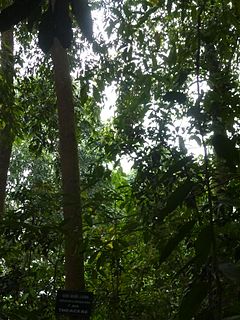
Cupaniopsis is a genus of about 67 species of trees and shrubs of the soapberry family, Sapindaceae. They grow naturally in New Guinea, New Caledonia, Australia, Torres Strait Islands, Fiji, Samoa, Sulawesi, Micronesia. Many species have been threatened with extinction globally or nationally, with official recognition by the International Union for Conservation of Nature (IUCN) and several national and state governments.
Ormocarpopsis parvifolia is a species of flowering plant in the family Fabaceae. It is found only in Madagascar.
Heritiera parvifolia is a species of flowering plant in the family Malvaceae. It is found only in China. It is threatened by habitat loss.
Adinandra angulata is a species of plant in the Pentaphylacaceae family. It is a tree endemic to Peninsular Malaysia.

Adinandra is a genus of plant in the family Pentaphylacaceae. It contains the following species:
Adinandra corneriana is a species of plant in the Pentaphylacaceae family. It is a tree endemic to Peninsular Malaysia. It is threatened by habitat loss.
Adinandra forbesii is a species of plant in the Pentaphylacaceae family. It is endemic to New Guinea island, within the nation of Papua New Guinea, and in the Western New Guinea region of Indonesia. It is an IUCN Red List near-threatened species, endangered by habitat loss.
Adinandra griffithii is a species of plant in the Pentaphylacaceae family.

Adinandra integerrima is a species of plant in the Pentaphylacaceae family. It is found in Malaysia and Singapore. It is threatened by habitat loss.
Buchenavia rabelloana is a species of plant in the Combretaceae family. It is endemic to Brazil. It is threatened by habitat loss.
Mangifera parvifolia is a species of plant in the family Anacardiaceae. It is a tree found in Indonesia, Malaysia, and Singapore.
Prestonia parvifolia is a species of plant in the family Apocynaceae. It is endemic to Ecuador. Its natural habitat is subtropical or tropical dry forests. It is threatened by habitat loss.
Semecarpus parvifolia is a species of plant in the family Anacardiaceae. It is endemic to Sri Lanka.
Blakea parvifolia is a species of plant in the family Melastomataceae. It is found in Panama and Peru.
Vatica parvifolia is a tree in the family Dipterocarpaceae, native to Borneo. The specific epithet parvifolia means "small leaf".
Virola parvifolia is a species of plant in the family Myristicaceae. It is endemic to Brazil, Colombia and Venezuela.
Parashorea parvifolia is a species of plant in the family Dipterocarpaceae. The name parvifolia is derived from Latin and refers to species small leaves. It is endemic to Borneo. It is a large emergent tree, up to 60 m tall, found in mixed dipterocarp forests on fertile clay soils. It is present in protected areas, including Lambir Hills National Park.
As of July 2016, the International Union for Conservation of Nature (IUCN) lists 238 conservation dependent species. 0.29% of all evaluated species are listed as conservation dependent. The IUCN also lists seven subspecies and five varieties as conservation dependent.
Shorea parvifolia is a species of tree in the family Dipterocarpaceae, commonly known as light red meranti and white lauan. It is native to tropical southeastern Asia.

Tenompok Forest Reserve is a protected forest reserve in Ranau District of West Coast Division, Sabah, Malaysia. It was designated as a Class 1 Forest Reserve by the Sabah Forestry Department in 1984. Its area is 1,984 hectares (19.84 km2). A former reserve, the Kampung Bundu Tuhan Native Residence Reserve, occupied what is now the eastern portion of Tenompok. The reserve is mountainous, reaching 1,660 metres (5,450 ft) above sea level. Vegetation consists of lower montane forest and montane kerangas forest. Both share a similar species composition, although trees in montane keranga forests are smaller. The reserve's Tomis River is a tributary of the Tuaran River. The area of the reserve has never received significant logging, aside from small amount near what are now its borders. This small logging is thought to be carried out by nearby villages for local use. There is also some agricultural encroachment. The reserve lies between Kinabalu Park and Crocker Range National Park. One farmer has a house within the reserve. There are several settlements around the reserve, along with agricultural land.



